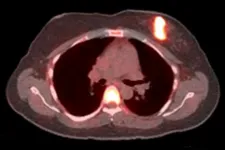(Press-News.org) A combination of genetic mutations may explain the higher incidence of and poorer outcomes from pediatric leukemia in Hispanic and Latino children, according to Penn State College of Medicine researchers. They said a novel therapeutic drug combination - as well as testing for these mutations - may help address the disparity.
Hispanic and Latino children are between 1.2 and 1.75 times more likely to develop B-cell acute lymphoblastic leukemia (B-ALL), the most common childhood cancer, than non-Hispanic and Latino children. They also have a 40% higher death rate than their counterparts after correcting for socioeconomic factors. Dr. Sinisa Dovat, a researcher and pediatric oncologist at Penn State Children's Hospital and Penn State Cancer Institute, partnered with Dr. Gordana Raca of Children's Hospital Los Angeles and Kimberly J. Payne of Loma Linda University to understand the biology behind this health disparity after prior research suggested that there may be an increased frequency of a type of genetic mutation in Hispanic and Latino children with B-ALL.
The researchers studied 239 pediatric patients with B-ALL at Children's Hospital Los Angeles and found two types of genetic mutations - a deletion of the IKZF1 gene (IKZF1) which holds instructions for cells to make the IKAROS protein and a rearrangement, or translocation, of the gene with instructions for producing the CRLF2 protein - occurred more frequently in Hispanic and Latino children. IKZF1 deletion occurred two times more frequently in those children - making it the most frequent genetic alteration that signals poor prognosis of B-ALL. There was a four-fold increased incidence of CRLF2 translocations in Hispanic and Latino children, as compared to non-Hispanic and Latino children.
"These mutations offer an explanation for the poor prognosis and increased incidence of B-ALL in Hispanic and Latino children and offer us insight into this pediatric cancer health disparity," Dovat said.
The researchers found that 11% of Hispanic and Latino children had both mutations compared to 0% of their counterparts. Almost all of the Hispanic and Latino children with B-ALL who had a specific type of CRLF2 translocation also had an IKZF1 deletion, while a large number of them had an IKZF1 deletion without that specific type of CRLF2 translocation. According to Dovat, these results suggest that IKZF1 deletion precedes or predisposes the CRLF2 gene to mutation. The findings were published today, Feb. 2, in Leukemia.
Dovat said that further research is needed to understand the biological mechanisms for why these gene mutations happen more frequently in Hispanic and Latino children.
"Sequencing these genes in Hispanic and Latino children with B-ALL is essential to help pediatric oncologists determine a prognosis for these patients and develop appropriate treatment plans," Dovat said. "Treatments that can restore the function of the IKAROS protein could be an efficient treatment for leukemia."
In a companion study, also published today in Leukemia, Dovat and colleagues outlined a treatment strategy that may be beneficial to patients suffering from this health disparity. It involves targeting a protein, mTOR, that when over produced, can lead to resistance to chemotherapy and poor prognosis.
"The CRLF2 mutation, often found in Hispanic and Latino children with B-ALL, leads to increased activity of mTOR, which has been associated with poor outcomes," Dovat said. "We proposed that an effective treatment regimen would hinder the activity of the mTOR protein, but also target the gene that carries the instructions for making mTOR by restoring the function of the IKAROS protein."
The researchers developed a combination therapy, starting with a drug that restores the function of IKAROS by inhibiting another protein called casein kinase 2 (CK2). When CK2 is prevented from carrying out its function, the IKAROS protein can keep mTOR from being produced. The team also used a second drug called rapamycin to inactivate mTOR proteins already present in cancer cells.
Dovat and his colleagues evaluated this approach in the lab by using the combination, and each drug individually, on cancer cells from Hispanic and Latino patients. They also later tested the approach against each drug individually and in combination in an animal model of leukemia using cancer cells from Hispanic and Latino pediatric B-ALL patients. They found that in both instances, the combination of two drugs proved more effective against leukemia than either drug individually. These studies laid the groundwork for a Phase I clinical trial with this treatment and provided a new paradigm for similar approaches to treat cancer using dual targeted treatments.
"We've identified a new approach for treating high-risk B-cell acute lymphoblastic leukemia," Dovat said. "Our work established the foundation for clinical testing of a new combination therapy that may address health disparities and benefit patients who suffer from pediatric leukemia."
INFORMATION:
Feng Yue, James Broach, Chandrika Gowda, Joseph Schramm, Dhimant Desai, Elanora Dovat, Tommy Hu, Arthur Berg, Zheng Ge, Chunhua Song, Yali Ding, Bi-Hua Tan, Arati Sharma, Raghavendra Gowda, Suming Huang, Vladimir Spiegelman, Soumya Iyer, Pavan Kumar Dhanyamraju, Yuka Imamura, Daniel Bogush, Yevgeniya Bamme, Mario Soliman, Shriya Kane, Mary McGrath, and Zissis Chroneos of Penn State College of Medicine; Hisham Abdel-Azim and Deepa Bhojwani of Children's Hospital Los Angeles; Jonathon Payne and Mark Reeves of Loma Linda University College of Medicine; and Yiping Yang of Ohio State University College of Medicine also contributed to this research. Penn State authors declare no conflicts of interest.
This work was supported by the National Institutes of Health (R01CA209829, R01CA213912, F30CA221109, R01DK110108, R01CA204044, R35GM124820, R01HG009906,) National Natural Science Foundation of China (NSFC 81770172), Penn State Clinical and Translational Science Institute through the National Center for Advancing Translational Science (KL2TR002015), Four Diamonds, Hyundai hope on Wheels Scholar Grants, Alex's Lemonade Stand Foundation, St. Baldrick's Foundation Career Development Award, the Rally Foundation and Children's Miracle Network. The content is solely the responsibility of the authors and does not necessarily represent the official views of the NIH or other funders.
COLUMBUS, Ohio - People who start adulthood with a body mass index (BMI) in the normal range and move later in life to being overweight - but never obese - tend to live the longest, a new study suggests.
Adults in this category lived longer than even those whose BMI stayed in the normal range throughout their life. Those who started adulthood as obese and continued to add weight had the highest mortality rate.
"The impact of weight gain on mortality is complex. It depends on both the timing and the magnitude of weight gain and where BMI started," said Hui Zheng, lead author of the study and associate ...
According to the Barker hypothesis (Hales and Barker 1992) (also referred to as "small baby syndrome"), infants with too low body weight have an increased risk of suffering from cardiovascular diseases, high blood pressure, diabetes and chronic kidney diseases in adulthood. According to this hypothesis, fetal protective mechanisms enable adaptation to unfavorable intrauterine conditions (chronic oxygen or nutrient deficiency) and allow for fetal survival. At the same time, however, they lead to permanent structural and functional strains and changes into adulthood. The comprehensive study recently published in Nature Communications now clarifies central mechanisms of this phenomenon.
Fetuin-A plays a key role
Under the program of the Swiss National ...
ATLANTA - FEBRUARY 2, 2021 - A new study finds that long-term aspirin use before a diagnosis of colorectal cancer (CRC) may be associated with lower CRC-specific mortality. The report that appears in JNCI: The Journal of the National Cancer Institute, suggests that the findings for pre-diagnosis aspirin use might help reduce CRC mortality in the overall population by limiting metastatic spread of colorectal tumors before diagnosis. Preventing distant metastases leads to fewer deaths from colorectal cancer.
The study, led by Peter T. Campbell, PhD, of the American Cancer Society, used data from men and women enrolled in the American Cancer Society's Cancer Prevention Study-II (CPS-II) Nutrition Cohort who were cancer-free ...
A surgical procedure meant to counter ulcerative colitis, an immune disease affecting the colon, may trigger a second immune system attack, a new study shows.
The study results revolve around the immune system, the cells and proteins that destroy invading bacteria and viruses. Activating it brings about inflammation, responses like swelling and pain that result from cells homing in on the site of infection or injury. Autoimmune diseases like ulcerative colitis occur when this system mistakenly damages the body's own tissues.
Colon tissue damaged by the disease is routinely addressed with a "J-pouch" procedure wherein a pouch is surgically constructed from nearby, healthy ...
Toronto, ON - Results of a multi-centre, international, clinical trial co-led by Peter Munk Cardiac Centre (PMCC) cardiologist Dr. Dinesh Thavendiranathan point to the benefit of using a more sensitive test to detect heart function issues early, so cancer patients don't have to fight heart failure too.
Unfortunately, for 1 in 20 high-risk patients, treating cancer with certain therapies means the added potential of developing heart failure. The one-year results of the highly anticipated trial compared heart function at the end of anthracycline-based chemotherapy, a treatment that can successfully treat cancer but ...
DALLAS, Feb. 2, 2021 — Young, Black adults are more than twice as likely to die in the first year after a heart transplant when compared to same-age, non-Black heart transplant recipients, according to new research published today in Circulation: Heart Failure, an American Heart Association journal.
Research has consistently shown that Black heart transplant recipients have a higher risk of death following heart transplantation compared to non-Black recipients. Black patients have higher prevalence of cardiovascular disease at younger ages, and therefore, they may need heart transplants at younger ...
Hormone therapy commonly is given as a targeted treatment for women whose cancer cells carry receptors for estrogen. But the therapy only works for about half of all patients. Until now, there hasn't been a good way to reliably predict who will benefit and who will not.
Researchers at Washington University School of Medicine in St. Louis have shown they can distinguish patients likely or unlikely to benefit from hormone therapy using an imaging test that measures the function of the estrogen receptors in their cancer cells. In a small phase 2 clinical trial, the researchers showed that the cancers of all patients with working estrogen receptors remained stable or improved on hormone therapy, and progressed in all women with nonfunctional ...
A new method for constructing special solar cells could significantly increase their efficiency. Not only are the cells made up of thin layers, they also consist of specifically arranged nanoblocks. This has been shown in a new study by an international research team led by the Martin Luther University Halle-Wittenberg (MLU), which was published in the scientific journal Nano Letters.
Commercially available solar cells are mostly made of silicon. "Based on the properties of silicon it's not feasible to say that their efficiency can be increased indefinitely," says Dr Akash Bhatnagar, a physicist from the Centre for Innovation Competence (ZIK) "SiLi-nano" at MLU. ...
CHARLOTTESVILLE, VA (FEBRUARY 2, 2021). Researchers in the United Kingdom (UK) conducted a randomized controlled trial in 47 patients with lumbar spinal stenosis to compare treatment outcomes and costs of two competing surgical procedures: insertion of the X-Stop® (Medtronic) interspinous distractor device and open decompression surgery with laminectomy. Both procedures improved the patients' quality of life; however, overall, laminectomy gave patients a better quality of life and was also more cost-effective.
Detailed findings of this study can be found in a new article, "A randomized controlled trial of the X-Stop interspinous ...
Abu Dhabi, UAE, February 2, 2021: Adolescent mothers often fall through the cracks of educational programming. This is highly problematic given that globally an estimated 12 million girls between the ages of 15-19, and 777,000 girls under the age of 15, give birth each year. In populations affected by conflict and displacement, adolescent girls have an increased likelihood of becoming mothers due to various factors, such as disruptions to schooling, the loss of family members, poverty, gender-based violence, and poor access to healthcare and sexual and reproductive services and resources. There is a lack of support programs for these young mothers, and a continuing need for educational programming. ...



